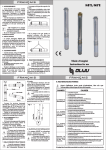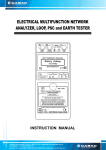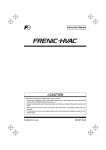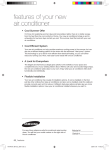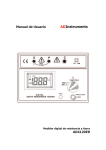Download English (GB) Installation and operating instructions
Transcript
English (GB) English (GB) Installation and operating instructions 1. Symbols used in this document Original supplement to Quick Guide. CONTENTS Warning If these safety instructions are not observed, it may result in personal injury! Page 1. Symbols used in this document 8 2. System sizing 8 3. Mechanical installation 8 4. Electrical connection 9 5. Start-up 9 6. Alarms 6.1 Anti-cycling 9 9 7. Fault finding chart 10 8. Disposal 11 Warning Prior to installation, study the Quick Guide carefully. Installation and operation must comply with local regulations and accepted codes of good practice. Warning The use of this product requires experience with and knowledge of the product. Persons with reduced physical, sensory or mental capabilities must not use this product, unless they are under supervision or have been instructed in the use of the product by a person responsible for their safety. Children must not use or play with this product. 8 Caution Note If these safety instructions are not observed, it may result in malfunction or damage to the equipment! Notes or instructions that make the job easier and ensure safe operation. 2. System sizing Warning The system in which the CM Booster is incorporated must be designed for the maximum pump pressure. Caution The default setting will cause the pump not to stop until it reaches its maximum pressure. 3. Mechanical installation Warning Before starting any work on the CM Booster, make sure that the power supply has been switched off and that it cannot be accidentally switched on. The electrical connection should be carried out by an authorized electrician in accordance with local regulations. Warning Check that the supply voltage and frequency match the voltage and frequency on the nameplate. Warning Before making any connections in the unit, make sure that the power supply has been switched off and that it cannot be accidentally switched on. The unit must be connected to an external mains switch with a contact gap of at least 3 mm in all poles. As a precaution, the unit must be connected to a socket with earth connection. We recommend to fit the permanent installation with an earth leakage circuit breaker (ELCB) with a tripping current < 30 mA. 5. Start-up Caution English (GB) 4. Electrical connection Do not start the pump until it has been filled with liquid. 6. Alarms Caution If a dry-running alarm has been activated, find the cause before the pump is restarted in order to prevent damage to the pump. 6.1 Anti-cycling Note In case of a very small consumption, the anti-cycling function may detect this as cycling and stop the pump inadvertently. If this occurs, the function can be disabled. Enabling and disabling the function 1. Press [Reset] for 3 seconds until "Power on" starts flashing. 2. Select whether the function should be enabled or disabled. Each time [Reset] is pressed, the unit will change between enabled and disabled. "Pump on" is off when the function is disabled. "Pump on" is on when the function is enabled. Press [Reset] for 3 seconds to return to operation. 9 7. Fault finding chart English (GB) Warning Before starting work on the pump, make sure that the power supply to the pump has been switched off and that it cannot be accidentally switched on. Fault Cause Remedy 1. a) The fuses in the electric installation have burnt. Replace the fuses. If the new fuses also burn, check the electric installation. b) The earth leakage circuit breaker or the voltage-operated circuit breaker has tripped out. Cut in the circuit breaker. c) No power supply. Contact the power supply authorities. d) The PM unit is defective. Repair or replace the PM unit. a) The power supply to the pump is disconnected after the PM unit. Check the plug and cable connections, and check if the built-in circuit breaker of the pump is switched off. b) The motor protection of the pump has tripped out due to overload. Check if the motor/pump is blocked. c) The pump is defective. Repair or replace the pump. d) The PM unit is defective. Repair or replace the PM unit. a) Too big difference in height between the PM unit and the tapping point. Adjust the installation, or select a PM unit with a higher start pressure. b) The PM unit is defective. Repair or replace the PM unit. 2. 3. 4. 5. 6. 7. 10 The green "Power on" indicator light is off. The green "Pump on" indicator light is on, but the pump does not start. The pump does not start when water is consumed. The "Pump on" indicator light is off. Frequent starts/stops. The pump does not stop. The red "Alarm" indicator light is permanently on. The red "Alarm" indicator light is flashing. a) Leakage in the pipework. Check and repair the pipework. b) Leaky non-return valve. Clean or replace the non-return valve. c) A valve close to the PM 1 outlet has been closed. Open the valve. a) The pump cannot deliver the necessary discharge pressure. Replace the pump. b) A PM unit with too high start pressure is installed. Select a PM unit with a lower start pressure. c) The PM unit is defective. Repair or replace the PM unit. d) The non-return valve is stuck in open position. Clean or replace the non-return valve. a) Dry running. The pump needs water. Check the pipework. b) The power supply to the pump is disconnected after the PM unit. Check the plug and cable connections, and check if the built-in circuit breaker of the pump is switched off. c) The motor protection of the pump has tripped out due to overload. Check if the motor/pump is blocked. d) The pump is defective. Repair or replace the pump. e) The PM unit is defective. Repair or replace the PM unit. a) Cycling. A tap has not been closed entirely after use. Check that all taps have been closed.



